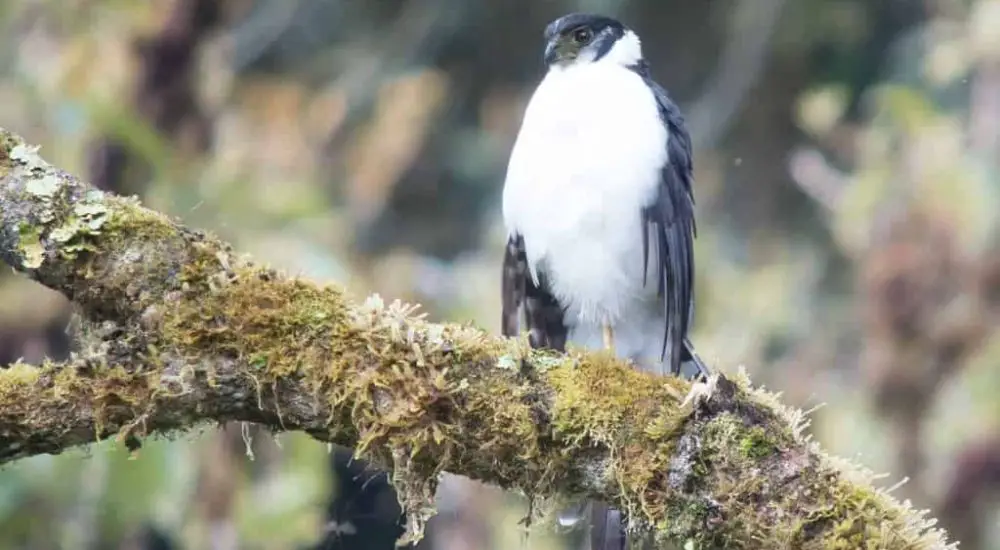
There are eight different species of falcons you can see in Texas.
Table of Contents
ToggleThese are:
- Collared Forest Falcon
- Aplomado Falcon
- American Kestrel
- Crested Caracara
- Merlin
- Gyrfalcon
- Peregrine Falcon
- Prairie Falcon
Want to learn more? This book on the Birds of Prey of North America is a fantastic read!
Texas is one of the most popular states for bird watching, not only being home to the eight species of aforementioned falcons, but it also provides homes for thirteen different species of hawk. The northwest of Texas hosts a continental climate, with warm humid summers and cold, dry winters.
The rest of Texas is classified as having a subtropical climate. There are 80 different state parks in Texas but there are only 2 national parks, Guadalupe Mountains and Big Bend.
One of the most common falcon in Texas is the Peregrine Falcon, Texas University is known to have their own resident one nicknamed Tower Girl.
Now that we’ve talked about what falcons we can find, lets look at these falcons in a little more detail.
Want to attract birds of prey to your yard? Take a look at our article!
What Falcons can be seen in Texas?
Table of Contents
1. Collared Forest-Falcon

Wingspan
72cm - 86cm
Weight
480g - 940g
Life Expectancy
Up to 3 years
Diet
Varied diet but mainly small birds
The Collared Forest-Falcon is less studied than other species of falcon as it prefers to live in deep forest and is rather secretive when it comes to its nest.
It has dark brown feathers covering its back and it has a bright white belly.
As with most birds, the female is larger than the male. During the courting display period, Collared Forest Falcons can be often heard calling to each other in duets, the noise being described as a “cohw, cohw, cohw,”.
The first Collared Forest-Falcon to be seen in Texas was in 1994 at Bentsen State Park. This has been the only time this falcon has been seen in the states and considering this state park borders along Mexico, it’s a good place to try and spot on of these birds.
Their habitats are in deep forests, so they are hard to spot and you’ll have to be vigilant.
Collared Forest-Falcons are non-migratory meaning that they can be seen in Texas year-round. However, the best chance to spot one can depend on the time of day. They mainly hunt at dawn and dusk and can be heard calling at these times.
2. Aplomado Falcon
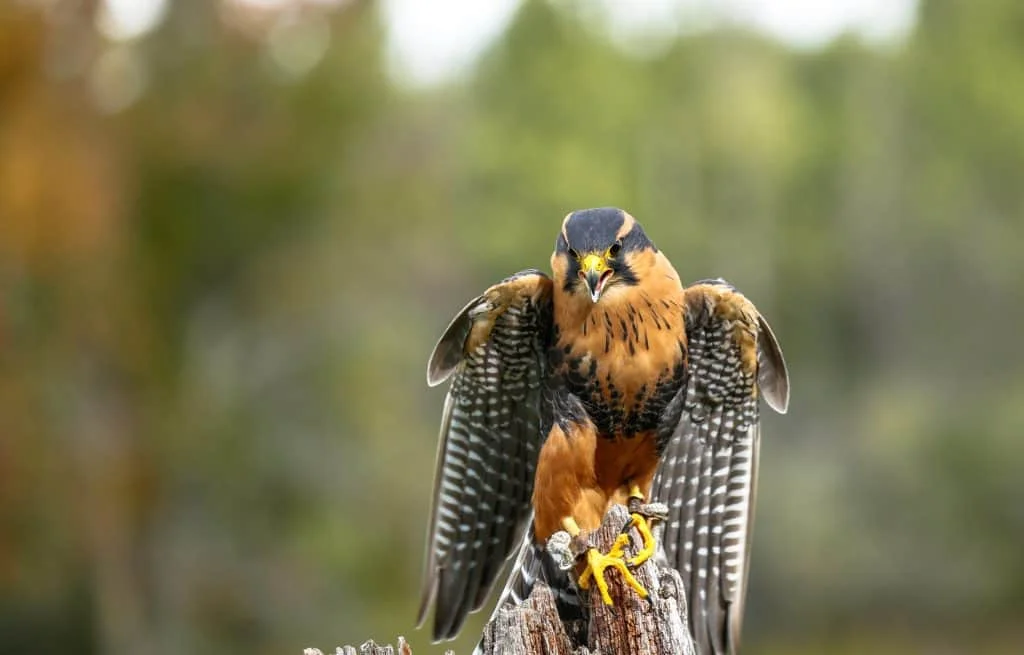
Wingspan
89cm
Weight
200-500g
Life Expectancy
Up to 12 years
Diet
Insects and Lizards
Aplomado Falcons have black and white heads with rusty feathered bellies and a brown feathered back.
They are large birds with powerful flight and are very fast even on foot, some choosing to chase their prey down on the ground.
Breeding pairs of these falcons stay together, perching and hunting at the same time. Their courtship displays involve chasing each other through the sky.
You are most likely to spot an Aplomado falcon in the southern parts of Texas and the Trans-Pecos Regions. The reason for this is that these birds are much more common in Mexico, so the birds are more likely to be found close to the border. You are most likely to see these birds in grassland and desert habitats.
Aplomado falcons are present in the state of Texas year-round, the best time to see them usually depends more on the time of day than the month of the year. These birds hunt in pairs and usually do so earlier in the morning.
3. American Kestrel

Wingspan
51-61cm
Weight
80-165kg
Life Expectancy
11 Years
Diet
Insects, some small rodents / birds
The American Kestrel is the smallest falcon found in North America. They have a slate blue head with their bellies and backs being covered in rusty brown feathers.
These birds are happy to make their nests near human modified areas, making sure to nest in denser tree areas when it is time to mate.
American Kestrels are known to be very territorial, particularly during mating season.
A male may make various swooping dives from his nest to advertise its territory, they have also been known to group up and attack hawks that invade their nesting areas during mating season.
American Kestrels can be found across the whole state of Texas and with them being relatively common a lot of work has been done on their mapping distribution.
Across a variety of ecological areas in Texas it was found that the two areas with the highest amount of these birds were Rolling Plains and Pineywoods.
These areas are a good place to start if you want to see one of these birds, look for tall trees and manmade structures where they may build their nests.
The mating season for this falcon is during the spring and can range from March to August, this is the best time to see an American Kestrel as they are more active and territorial during the mating season.
You are also more likely to see these birds during the middle of the day which is when they hunt.
Males will also bring food for females during the mating season so their hunting activity throughout the day increases, giving you a great chance to spot the American Kestrel in action.
4. Crested Caracara
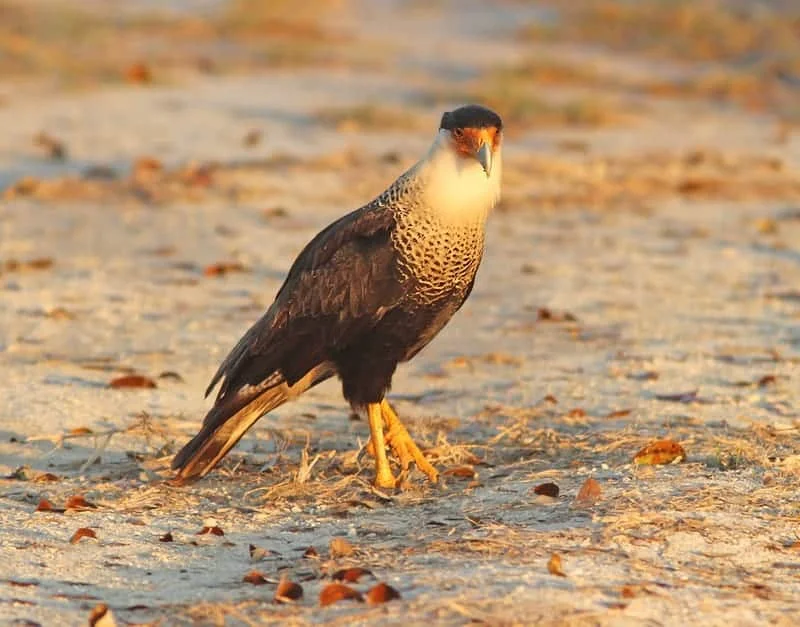
Wingspan
125cm
Weight
1050-1300g
Life Expectancy
26 years
Diet
Carcasses
The Crested Caracara is a medium sized falcon covered in black feathers, it has a white neck and a thick heavy bill.
These birds tend to avoid densely wooded areas as the trees can disrupt their hunting, they hunt by using the ground to run a short while before taking flight.
During the mating season is the only time these falcons will interact with others from their species, breeding pairs usually stay together for a number of years.
They also keep their nests and territories year round and are territorial. If possible, these falcons will use the same nesting tree within their territory during the mating season, but they will never raise their eggs in a nest outside of their territory.
The best place to look for these birds is in open areas of Texas such as farmlands and sometimes even golf courses.
In these areas they will nest in the tallest tree or similar structure that they can find, these tall areas are where you are most likely to spot a breeding pair of Crested Caracaras.
Crested Caracaras are residents in Texas throughout the whole year but the best chance to see these falcons is during their mating season.
Their mating season has a wide range and can last from January to September, but it is most commonly in the first six months of the year. They are much more active during these times, they are more territorial towards other bird species and also have greater hunting activity.
5. Merlin
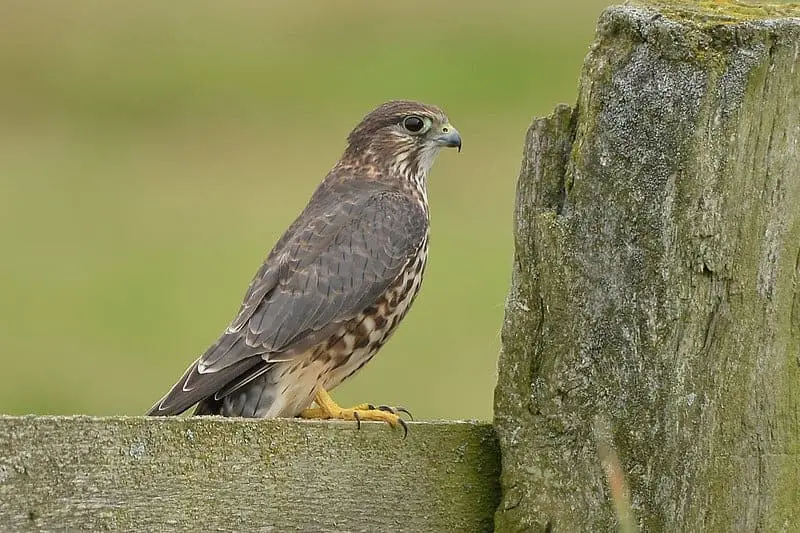
Wingspan
58-63cm
Weight
160-240g
Life Expectancy
Up to 10 years
Diet
Small birds
The Merlin, not to be confused with the wizard of legend, is a small falcon with dark, streaky feather patterns covering its body.
These birds are usually found in open areas of North America, but they have recently been observed breeding and nesting closer to the urban cities.
Merlins do not often make their own nests, instead they prefer to use abandoned nests that other birds, such as crows, have already made.
During the breeding season Merlins are monogamous and only mate with one individual. However, they do not mate for life and many will find new breeding partners year after year.
These falcons have a large home range but in Texas you are most likely to see one in the northern and central regions of the state.
Your best chance to see one is by taking a drive on the open road as Merlins prefer to stay in open areas such as prairies.
Whilst Merlins can be found year-round in Texas, a lot of these birds migrate south in the winter so you will have a better chance of spotting one from October to January.
This is because birds staying in the northern states of America will often migrate to southern states such as Texas, greatly increasing the abundance of these falcons in the lone star state.
6. Gyrfalcon
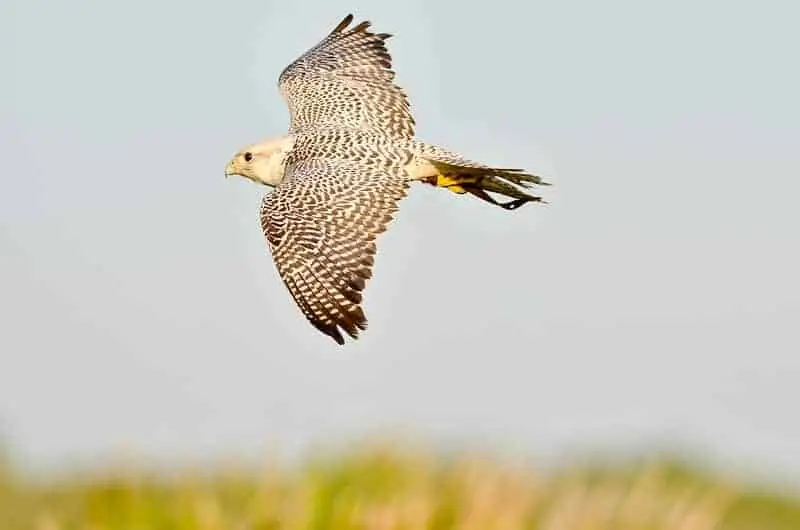
Wingspan
123cm
Weight
800-2100g
Life Expectancy
Up to 14 years
Diet
Mostly small birds
The Gyrfalcon is a large species of falcon covered in grey streaky feathers. As with lots of birds of prey, the females of this species are bigger than the males.
These birds prefer to make their nests in tundra habitats, building them on the cliffsides up to 5000ft in elevation.
Gyrfalcons mate for life and they often spend the whole year with their mate, not just the breeding season.
Their courtship displays are performed by the sole male, who will do a series of aerial dives and rolls. They are very territorial and will mark their territory using vocal calls.
Gyrfalcons are very rare in Texas as most stay in places with arctic climates such as Canada. However, it is possible to see these birds on the northern border of Texas as there are some small numbers that will migrate this far south.
Your best chance of seeing one will be on the cliffsides near water.
If you hope to see one of these birds in Texas, you will only be able to do so in the winter months when the Gyrfalcon migrates.
It is still unlikely to see one of these in Texas, but if you are lucky or determined enough your best month for falcon watching is in December.
7. Peregrine Falcon
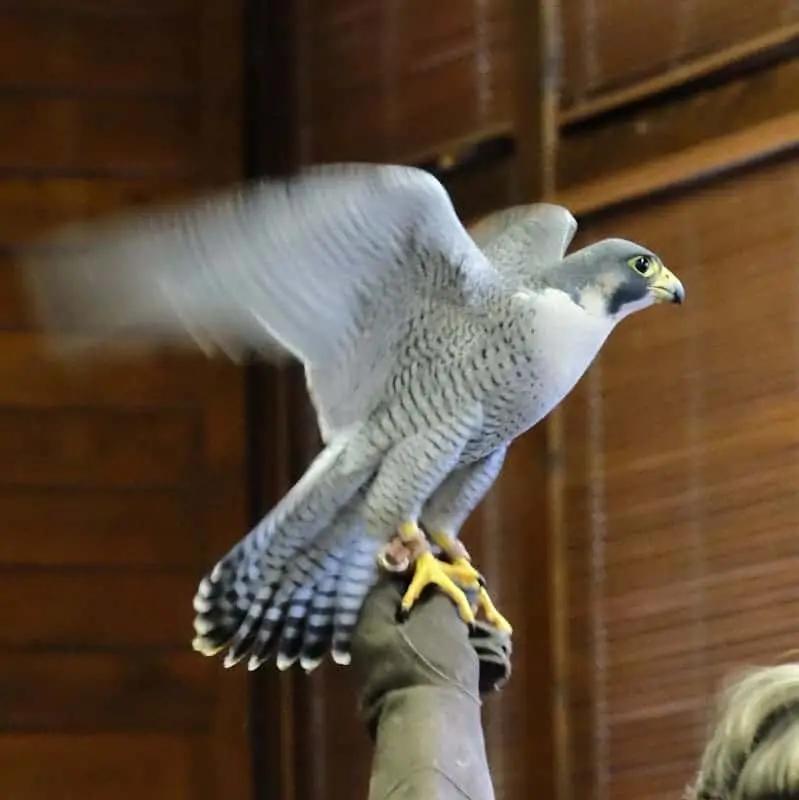
Wingspan
1m
Weight
500-1600g
Life Expectancy
17 Years
Diet
Mostly birds
Peregrine Falcons are found all across the world and are one of the largest falcons. They have dark grey feathers covering their back and a white feathered belly.
These birds hunt by using an aerial dive method and have been said to achieve speeds of over 200mph during their dive.
For this reason, they are said to be the fastest birds in the world. During the mating season, the male will prepare several nesting sites for the female to choose her favourite one.
In Texas, it is only one subspecies of Peregrine Falcon that can be found. The best place to try and spot one of these is in Rio Grande, close to the border.
Some other Peregrine Falcons may migrate to north central Texas, but these are only in certain months and not year-round like the ones in Rio Grande.
The best chance to see the native Texan subspecies of Peregrine falcon is during their breeding season, this season begins in February and can last till July.
However, if you want to see Peregrine Falcons in the north and central parts of the state, you’ll have to wait until the winter months of November to January when their migrations happen.
8. Prairie Falcons
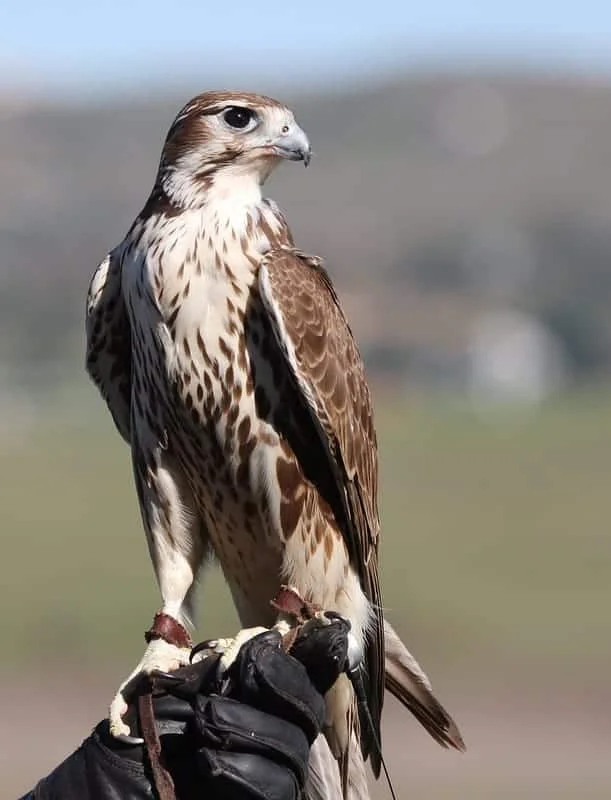
Wingspan
90-113cm
Weight
420-1100g
Life Expectancy
17 years
Diet
Small mammals
The Prairie Falcon is a medium species of falcon covered in deep brown feathers. As the name suggests, it prefers open prairie lands, including grasslands. In the mating season, the male and female will pick their nest locations together. Visiting various possible sites before settling and building one.
During courting the two falcons will vocalise to one another and they spend the nights roosting near to their breeding partner.
The Prairie Falcon is most common in the western areas of Texas. They will make their nests on cliffsides where available and if possible, these cliffsides will be near large open areas for hunting. You are most likely to see one of these birds soaring over open grasslands looking for prey.
The best time of year to see these falcons in Texas is in the winter months when they migrate south. Some birds will migrate as far as the centre of Texas.
Their migration is not a large scale one and usually only occurs during November and December. However, some do stay in Texas all year, this is just your best chance to see one.

More Articles.
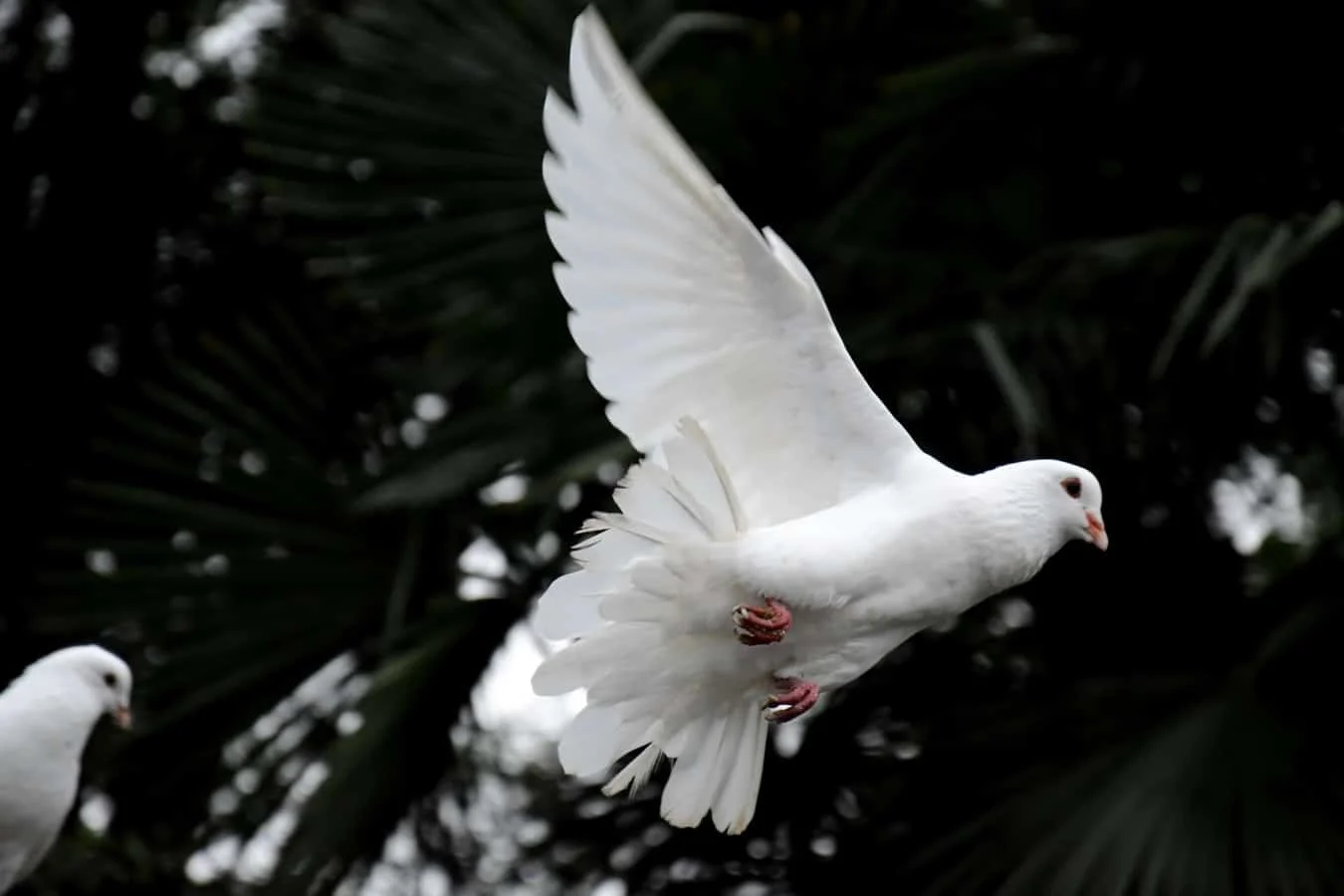
How to Attract Doves to your Yard?
Doves are beautiful birds with many sentimental attachments. Most people affiliate doves with positivity, love,
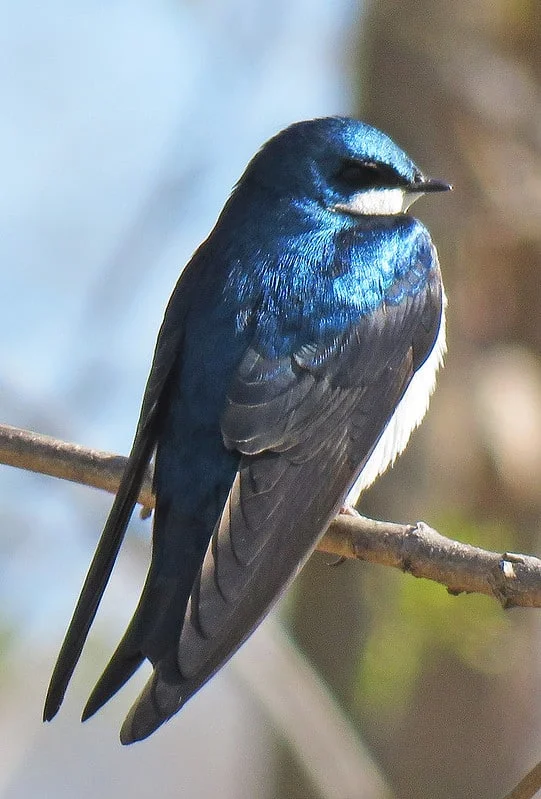
North American Birds with Blue Wings (13 Species with Pictures and Sounds)
North America is filled with many wonderful birds with blue wings – in fact, there
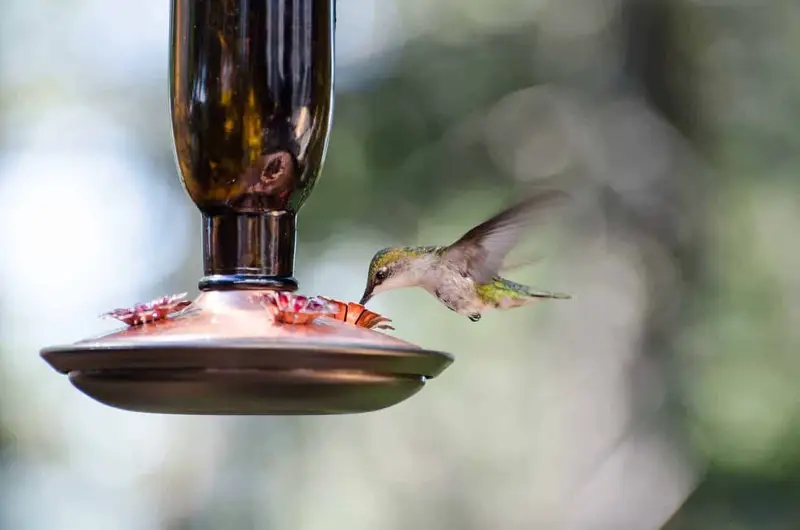
Best Hummingbird Feeders for 2020
Nectar bird feeders are well-known for attracting a variety of adorable birds and for saving

About Us
We are avid bird-watchers who recently retired, allowing us more time to travel the world. Fortunately, we have managed to visit numerous countries around Europe, Asia, and America. Watching and photographing birds has been a passion for many years and we are making the most of the extra time on our hands!


My wife and I were setting in the back yard and seen a peregrine falcon. A couple of weekends ago we thought we saw a hawk. When I looked on your site I realized it was a prairie falcon. My wife has seen the peregrine a few times this was my first time seeing on without a tether. It was awesome!!!
In kyle texas